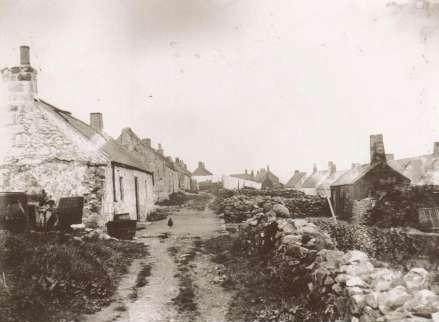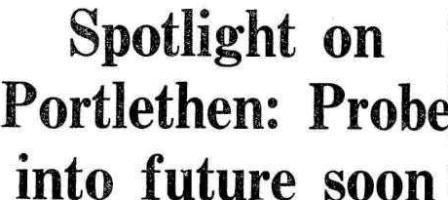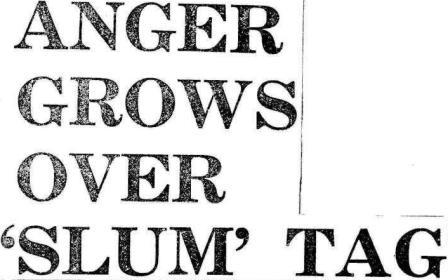
1950’s to 1970’s |
By the time the 1950’s had arrived there was a huge question mark over the usefulness of keeping these villages, particularly Downies, and to a lesser extent Portlethen. The local councillors and planners were of the mind that it would be far more cost effective and viable to let the villages fall to ruin and develop a new village in their place. The idea being that a “new town” of Portlethen would be developed around the area of Cookston, at the site of railway station and next to the main road. Their opinion being that there would be more benefits in creating something new near the main points of communications such as rail and road, where upgrading services such as water, electricity and sewerage would be easier than attempting to upgrade the old and dying fishing villages.
![]()
The residents that remained in the fishing villages disagreed with this plan and put up a fight to keep the villages and stay where they were, not wanting to forfeit their history, their heritage, or their scenic settings atop the cliffs looking out to sea.
Battle commenced and a compromise appears to have been reached; in that during the late 1950’s and early 1960’s the coastal villages had their homes improved with proper running water, electricity and a new sewerage system. Additionally the rough tracks leading to the villages were upgraded and started to function as proper roads that were fit to handle vehicles. At the same time as this happened, the development of a “new town” at Portlethen commenced, with the building of the council estate of “Burnside Gardens”. With the completion of this estate we saw some of the old “village fishers” moving in to the new houses and also a few “incomers” which was very likely the prelude to what the future held for Portlethen once the old fishers had all gone.

From the 1960’s onwards the villages of Portlethen, Downies and Findon began to flourish again, albeit in a totally different direction from previous years. The fisher folk, by and large, had all gone save for one or two individuals who continued to work from the shores fishing their lobster creels on a part time basis. A new breed of villager was beginning to take their place – the commuter and the international oilman.
The dynamics of the coastal villages had by now changed. A few modern houses were being built in all three villages, the remnants and ruins of older fishing cottages were bulldozed away, and many of the existing houses started to be modernised to 20th century standards. We didn’t see wholesale changes, rather individual houses were built on old sites or old houses were renovated, which, in general, enhanced rather than degenerated the villages.
The timing of the “rebirth” of Portlethen, Downies and Findon worked out very well because within a few short years the oil boom was set to hit north east Scotland and these villages, with their coastal settings and views, would soon became sought after locations to live in. Not only were they close to the city of Aberdeen but they had retained enough of their character to be attractive to incomers. It wasn’t too long before the local accents were being supplemented by others of a more international flavour and soon there would be a mix of English, American, Canadian, Dutch and other foreign individuals staying in the villages, side by side, with the local people.

This pattern has continued to the present day, where all of the villages continue to have a few local people with roots entrenched in Portlethen’s past, living alongside the “inabootcomers” whose stay here is likely to be of a more transient nature, although it should be said that some of these “inabootcomers” from the 1970’s have remained and have became the new “local” people.
It’s at this point in our story that we leave Old Portlethen, Downies and Findon behind and focus more on the “new town” which was fast developing one mile to the west of the coastal strip. Originally known as Portlethen Station, this place soon took over the name of Portlethen from its coastal neighbour.
Portlethen Station, so called because of the railway station that had been opened here in 1850, only had a few houses and buildings dotted around it’s vicinity as recently as the 1950’s. There were Cookston Cottages, a string of around half a dozen other houses running parallel or near to the railway station, Portlethen Church, Portlethen School, the Jubilee Hall and a few individual houses or crofts outlying about a mile from the station near the edges of Portlethen Moss. Additionally there was a row of houses at Hillside that ran along the edge of the main road from Aberdeen to Stonehaven. With the nearness of the road and the railway, and being approximately equidistant from Old Portlethen, Findon, Downies and Hillside, it was perhaps an obvious choice to plan a new centre for this area, particularly as the school was already in place here.

The first development of any note that took place in Portlethen was the building of the estate of Burnside Gardens which took place around 1960. This was soon complemented by the building of the new primary school alongside the existing school, and the completion of this took education into the modern era.
With the building of new housing at Portlethen there was a need for new industry in the area as the only existing industry in the immediate vicinity was related to farming and agriculture with a few “cottage industries” such as the local “smiddy” (blacksmith). The fishing industry had long gone and ceased to exist in the area.
What about the development of Portlethen itself after the building of Burnside Gardens, the expansion of the school and the building of the meat factory?
From the early 1970’s things started to gather pace, particularly with the need for increased housing in north east Scotland to meet the demands of the new oil industry. It’s probably at this point in time where a lack of vision became apparent in respect to planning matters around Portlethen.

Nicol Place was built next to the Jubilee Hall, and that was soon followed by The Square immediately next to it. Before we knew what was happening there were a series of housing developments occurring one after the other, and at times overlapping each other. To the north of Burnside Gardens we saw the arrival of the “Scottish Specials” in the area that is now Thistle Drive, Claymore Avenue, Viking Place and Argyll Place. Around the same time it was being deemed acceptable that building could take place on or around Portlethen Moss and we started to see the arrival of brand new houses on the streets that are now Rowanbank Road, Mosside Drive, Glascairn Avenue and Dunvegan Avenue.
It would appear that each new housing estate that had began to arrive in Portlethen seemed to be planned on its own individual needs rather than being part of an overall structure that would benefit Portlethen in the long run. The series of new buildings continued to develop to the south and further into Portlethen Moss, each new estate tagging on to another estate that had only been built a few years prior. By the 1980’s we had a variety of different housing estates, built by a variety of different building companies, spreading throughout Portlethen without any links, lacking in amenities, minus an obvious heart and with no sign of a master plan in sight. You could argue a case that, at this particular time, Portlethen had become a “dumping ground” for any housing requirements that were needed in north east Scotland.

Even as early as the mid 1970’s worried residents were starting to voice their concerns about the way Portlethen was developing, not only were they concerned but some of the community councillors were worried too, with one of them likening Portlethen to a slum. Most residents didn’t agree that Portlethen was like a slum but they did agree that improvements were badly required and I’ve quoted some of them from the local press in 1976.
The Press and Journal noted that there were a number of teenagers hanging about street corners when they visited Portlethen and one 17 year old was quoted as saying “It is about time we had a community centre, there is just nothing in Portlethen”. I would have had some empathy with that particular teenager; in fact the chances are I was a member of one of these groups that were hanging around the street corners when that was reported in 1976!

With these words of warning ringing in our ears, was there a marked improvement in planning, facilities, amenities and appearance by the end of the decade? Not according to an article in the Mearns Leader dated April 1979 which had the headline – Portlethen – The North East “Dump and Disaster Area”. The first paragraph in this article further states “According to the people who live there, Portlethen – The North Kincardine community that has mushroomed largely due to the oil boom – is a disaster area, messy in both design and appearance, unfinished and uncared for, and with no beauty to commend it. It is also, according to one Kincardine and Deeside District Councillor, “a dump”.
Portlethen had moved on a little by the end of the 1970’s and there was a small retail outlet of four shops on Rowanbank Road (still there today but in different forms) but the arrival of shops and amenities wasn’t keeping pace with the speed that the houses were being built. In tandem with this Portlethen was being provided by an inadequate bus service to and from Aberdeen and the railway station had closed long before the influx of houses had began in the 1960’s. We still had some way to go.